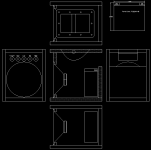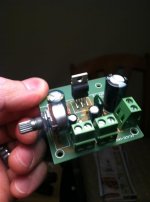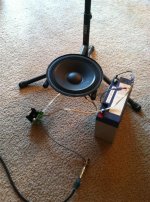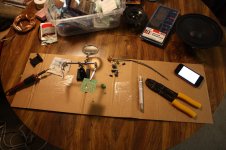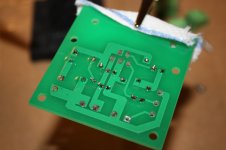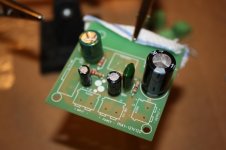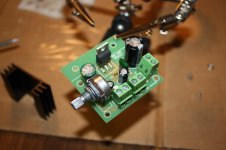Welcome to my first real adventure in building anything useful using my soldering iron. I'll use this thread to ask for help and share my progress as I build my latest project!
The goal is to build a portable amp for my cheap Indonesian Squire Strat that is flexible in the tones that it can reproduce, capable of lasting several hours on a charge, and loud enough to compete with an acoustic guitar, cajon, vocalist etc.
I've purchased an 8 Watt mono chipamp kit, an 8" Peavey speaker, and assorted bits to both finish the cabinet and build a control panel and preamp circuit. I also have a PowerSonic PS12180 SLA battery, an NTE858M low-noise JFET dual opamp, plenty of 22ga solid core wire, 20ga stranded core wire, heavy speaker wire, and a big messy bucket of unsorted resistors, capacitors and transistors.
Amp Kit: Class-AB 8W Mono Power Amplifier Kit TDA2003
Speaker: Peavey 8" Guitar Speaker 4 Ohms
Opamp: NTE858M Dual Low Noise JFET Input Datasheet
Battery: 12V 216 Whr Power-Sonic PS-12180-NB Sealed Lead Acid Battery
I'll build the cabinet out of a scrap piece of MDF I already have, mount the components and test the design, then likely build a proper cabinet out of plywood. I'll charge the battery with a small motorcycle-type trickle charger.
My questions to the great and infinite knowledge base that is DIYaudio:
1. What sort of preamp should I be considering for this project? MXR Distortion Plus? Ibanez Tubescreamer? A simple transistor fuzz? I want to do something simple, but opamps don't scare me and I really want a flexible tone, I want to hit bluesy notes AND screaming solos.
2. I would like to include a tone stack, where do I place it in the signal path? If I build a preamp with two stages of gain, perhaps in between the two stages? What is a buffer? Do I need one? Two?
3. How loud will my little chipamp be able to push the Peavey speaker? Can I expect decent volume? The Peavey speaker is 4Ohms, 91dB 1W/1m. I also considered a Jensen MOD-8 which may be a future upgrade if this goes well.
4. Do I need to worry about the preamp sending too hot of a signal to the chipamp and damaging it? How many mV come out of my Strat? How high should it be after the Preamp? Do I get better performance out of the chipamp by sending it a lower signal (500mV) and turning up the gain? Or turning up the preamp (1500mV) and keeping the amp volume reasonable?
5. Should I be considering a voltage regulator to protect my circuits? My battery puts out 12.45-12.75VDC. Ideally I'd like to run the TDA2003 near 15VDC, but that's not likely to be attainable on the cheap, and I don't think the preamp would appreciate it. I know I won't get good output from the TDA2003 if the supply voltage goes below 12VDC (It's good for 5-15v though.) Will my battery charger damage my precious circuitry if I charge the battery while it's connected? What about while it's on?
My parts arrive today, and I'll likely assemble the amp kit tonight and run my guitar into it just to see what happens. I've attached a quick CAD of my cabinet design with the speaker, battery, and carrying handle drawn in.
Thanks all and have a great day!
DK
The goal is to build a portable amp for my cheap Indonesian Squire Strat that is flexible in the tones that it can reproduce, capable of lasting several hours on a charge, and loud enough to compete with an acoustic guitar, cajon, vocalist etc.
I've purchased an 8 Watt mono chipamp kit, an 8" Peavey speaker, and assorted bits to both finish the cabinet and build a control panel and preamp circuit. I also have a PowerSonic PS12180 SLA battery, an NTE858M low-noise JFET dual opamp, plenty of 22ga solid core wire, 20ga stranded core wire, heavy speaker wire, and a big messy bucket of unsorted resistors, capacitors and transistors.
Amp Kit: Class-AB 8W Mono Power Amplifier Kit TDA2003
Speaker: Peavey 8" Guitar Speaker 4 Ohms
Opamp: NTE858M Dual Low Noise JFET Input Datasheet
Battery: 12V 216 Whr Power-Sonic PS-12180-NB Sealed Lead Acid Battery
I'll build the cabinet out of a scrap piece of MDF I already have, mount the components and test the design, then likely build a proper cabinet out of plywood. I'll charge the battery with a small motorcycle-type trickle charger.
My questions to the great and infinite knowledge base that is DIYaudio:
1. What sort of preamp should I be considering for this project? MXR Distortion Plus? Ibanez Tubescreamer? A simple transistor fuzz? I want to do something simple, but opamps don't scare me and I really want a flexible tone, I want to hit bluesy notes AND screaming solos.
2. I would like to include a tone stack, where do I place it in the signal path? If I build a preamp with two stages of gain, perhaps in between the two stages? What is a buffer? Do I need one? Two?
3. How loud will my little chipamp be able to push the Peavey speaker? Can I expect decent volume? The Peavey speaker is 4Ohms, 91dB 1W/1m. I also considered a Jensen MOD-8 which may be a future upgrade if this goes well.
4. Do I need to worry about the preamp sending too hot of a signal to the chipamp and damaging it? How many mV come out of my Strat? How high should it be after the Preamp? Do I get better performance out of the chipamp by sending it a lower signal (500mV) and turning up the gain? Or turning up the preamp (1500mV) and keeping the amp volume reasonable?
5. Should I be considering a voltage regulator to protect my circuits? My battery puts out 12.45-12.75VDC. Ideally I'd like to run the TDA2003 near 15VDC, but that's not likely to be attainable on the cheap, and I don't think the preamp would appreciate it. I know I won't get good output from the TDA2003 if the supply voltage goes below 12VDC (It's good for 5-15v though.) Will my battery charger damage my precious circuitry if I charge the battery while it's connected? What about while it's on?
My parts arrive today, and I'll likely assemble the amp kit tonight and run my guitar into it just to see what happens. I've attached a quick CAD of my cabinet design with the speaker, battery, and carrying handle drawn in.
Thanks all and have a great day!
DK
Attachments
Well, guitar amps are not built for "high fidelity"
They are built to get a certain sound.
This sound is a combination of the signal processing and the speaker / cabinet combination. Actually works better with tube amps because the speaker / cabinet combination impedance is reflected back to affect the output stage operation...more contribution to the characteristic sound of the whole package.
one thing they all have in common is a final output pot just before the final power amp.
prior to that it seems that anything goes.
preamp, tone, distortion, more tone, external FX loop, etc. mix and match.
There are a few different guitar tone stacks and somewhere on the net is a tone stack simulator. It demonstrates different stack types and you can change the component values and see the response graphically.
Search for "tone stack simulator".
IMHO: leave your design open to modification so you can truly experiment to get the sound you want.
have fun
They are built to get a certain sound.
This sound is a combination of the signal processing and the speaker / cabinet combination. Actually works better with tube amps because the speaker / cabinet combination impedance is reflected back to affect the output stage operation...more contribution to the characteristic sound of the whole package.
one thing they all have in common is a final output pot just before the final power amp.
prior to that it seems that anything goes.
preamp, tone, distortion, more tone, external FX loop, etc. mix and match.
There are a few different guitar tone stacks and somewhere on the net is a tone stack simulator. It demonstrates different stack types and you can change the component values and see the response graphically.
Search for "tone stack simulator".
IMHO: leave your design open to modification so you can truly experiment to get the sound you want.
have fun
Day 1 - Soldered the Amp Together
Parts arrived yesterday. I soldered together the amp kit but didn't have a power supply to test it with. Tonight I'll try it with my Powersonic battery. I'm going to run the leads from the 1/4" mono jack into the input, and the leads from the output straight into the speaker. I'll take some pics and shoot a little video, just so other curious people like myself know what it will sound like.
I'm aware that guitar cabinets are not hi-fi. You basically take the all the TS variables except Fs and sensitivity (maybe Qts) and throw them out the window when building a guitar cabinet! A 3/4" birch ply box with a 1/2" hardwood baffle is where I'll likely end up if this project is successful.
The tone stack simulator is really neat. I'm using this: Tone Stack Calculator
I'm not sure how to interpret what I'm seeing, it would be cool if I could pump an audio file through the calculator and play with the knobs that way. It's very interesting to see the different tone styles.
I am heading to my parents to build the cabinet on Sunday. I would like to have the preamp built before then. What would DIYaudio recommend as an ideal high-gain home for my NTE858M opamp?
Also, I'm using shielded microphone cable for all my signal wires. I'll likely be using this to connect the preamp to the amp since they're on separate PCB's. Should I be considering a quick-disconnect solution for simple modification? Can I use male>female spade connectors or will they degrade the signal too much?
Parts arrived yesterday. I soldered together the amp kit but didn't have a power supply to test it with. Tonight I'll try it with my Powersonic battery. I'm going to run the leads from the 1/4" mono jack into the input, and the leads from the output straight into the speaker. I'll take some pics and shoot a little video, just so other curious people like myself know what it will sound like.
I'm aware that guitar cabinets are not hi-fi. You basically take the all the TS variables except Fs and sensitivity (maybe Qts) and throw them out the window when building a guitar cabinet! A 3/4" birch ply box with a 1/2" hardwood baffle is where I'll likely end up if this project is successful.
The tone stack simulator is really neat. I'm using this: Tone Stack Calculator
I'm not sure how to interpret what I'm seeing, it would be cool if I could pump an audio file through the calculator and play with the knobs that way. It's very interesting to see the different tone styles.
I am heading to my parents to build the cabinet on Sunday. I would like to have the preamp built before then. What would DIYaudio recommend as an ideal high-gain home for my NTE858M opamp?
Also, I'm using shielded microphone cable for all my signal wires. I'll likely be using this to connect the preamp to the amp since they're on separate PCB's. Should I be considering a quick-disconnect solution for simple modification? Can I use male>female spade connectors or will they degrade the signal too much?
What would DIYaudio recommend as an ideal high-gain home for my NTE858M opamp?
If you are going down a road you have never travelled, look for a map! Find a similar combo amp out there in Google land and start with its schematic. About 15 years ago the kid next door blew up his little Peavey practice amp by wiring up too many speakers to it. I replaced the power amp chip and sent it home. It used a dual opamp for a preamp and had a reasonable sound for a practice amp. It was loud enough that he knew when I had fixed it (next door). Fender and a zillion others make similar designs, find one you like and start there.
I am working on a similar idea, but from a totally different perspective. I want a battery operated practice amp, but I want it to be a tube amp! Progress is very slow since I get delayed by life too often (recovering from pneumonia now). I have several LIPO batteries from model helicopters. They come in varying sizes up to about 5 AH and are very light weight. I just got the chips and transformer for the 400 volt supply. The tube amp will be the easy part. I want two different sizes. A medium size unit with 5 to 10 watts and a 5 to 8 inch speaker (I have several to choose from including one of those Peavey units) and at least a 3 hour run time. It will be built in a typical box. I also want a tiny unit that makes about a watt that fits INSIDE the guitar. I have several tiny speakers, but I may not like the sound of any of them.....only time will tell.
I found the schematic to the kids Peavey. My memory wasn't perfect....it uses 2 opamps to drive a 20 watt chip amp to 15 watts.....and soes it from 12 volts worth of batteries. Maybe a good start?????
The Free Information Society - Peavey Solo Electronic Circuit Schematic
The Free Information Society - Peavey Solo Electronic Circuit Schematic
Like you, I had intended to use tubes at the beginning. I found a beautifully simple power supply designed for those steampunk nixie tube wristwatches, (included a regulated 12VDC out and an adjustable 100-250VDC out) but in the end decided that I had better aim for something a bit closer to my skill level. Again, if this works, and it's fun, I'll likely try a starved tube preamp and a larger solid state power amp, maybe closer to 50W. This time with two of my Powersonic batteries for 24V!
I think I'm leaning towards the Ibanez Tubescreamer TS-9 as shown and described here: GM Arts - Guitar Amplifiers
That design will give me the opportunity to experiment with the placement of my tone stack before/between/after the opamp, as well as having a tone control in the last stage of the circuit for added flexibility.
That's also based on my assumption that the Tubescreamer will be a good fit for my opamp...will she survive? I should add, I'm placing the opamp in a socket for flexibility. I'll probably socket the transistor too, so I can replace it with others...or another JFET.
I think I'm leaning towards the Ibanez Tubescreamer TS-9 as shown and described here: GM Arts - Guitar Amplifiers
That design will give me the opportunity to experiment with the placement of my tone stack before/between/after the opamp, as well as having a tone control in the last stage of the circuit for added flexibility.
That's also based on my assumption that the Tubescreamer will be a good fit for my opamp...will she survive? I should add, I'm placing the opamp in a socket for flexibility. I'll probably socket the transistor too, so I can replace it with others...or another JFET.
I also want a tiny unit that makes about a watt that fits INSIDE the guitar. I have several tiny speakers, but I may not like the sound of any of them.....only time will tell.
Oh gosh. I love the sound of that. A buddy of mind has a solid body strat with all the hardware long gone that he uses as a doorstop...maybe I could chop a hole in it and mount a 3" full range speaker...hmm...hard to find one under 2" deep, and SPL is way down in the low 80dB range. @_@ CHALLENGE ACCEPTED!
Do you think it's even possible to build something decent into a solid body electric? I suppose you could put it inside an acoustic, but that's too easy...then again, the mess you make of the body's resonance by adding components to it would likely ruin the tone anyway. Flipping a hidden switch on your acoustic that magically doubles the volume and adds delay/reverb would be a pretty neat show!
assumption that the Tubescreamer will be a good fit for my opamp...will she survive?
I don't know why it wouldn't. Fed a reasonable supply voltage to the correct pins, opamps are pretty hard to kill. Some can be killed if the output is shorted to ground or B+, so don't do that and you're OK.
Using the tube screamer to drive the chip amp will leave you without tone controls. To me that would be the deal breaker, since I like to have knobs to turn.....the more the better. Even the Peavey circuit is kinda limiting. Is a second opamp out of the question. They don't eat much power, or money.
Do you think it's even possible to build something decent into a solid body electric?
I don't know, but I am going to find out. Back when I was a kid.....say the 1960's....there was store chain similar to what Radio Shack was 10 years ago. It was Lafayette Radio Electronics and there was a store near my house. They sold CB radios, stereos, guitars and amps. Mostly cheap stuff like you find at Radio Shack. They had an electric guitar with a solid state amp and a maybe 4 inch speaker. It might have cranked out a watt on a good day, and wasn't terribly loud, but I thought it was cool. I played it every time I went into the store. When the batteries were dying it had a cool distorted sound. Granted I was about 13, but I always wanted one...with a little more crank. I remember it was heavier and thicker than the other guitars too. So I am going to try to make one.
Fast forward 47 years, and 6 years of evening woodshop classes, and I have successfully made a few working solid body electric guitars. None have been spectacular and all used Fender necks from Ebay, but I am slowly getting there. I cut up an old waterbed frame and used the wood to make a few zero cost guitar bodies that are about 1 3/4 inch thick.
maybe I could chop a hole in it and mount a 3" full range speaker...hmm...hard to find one under 2" deep, and SPL is way down in the low 80dB range.
I have tried a few. I got a pair of Tang Band W2-1811S 2 inch full range neodymium speakers. The SPL is low, and I was not too impressed when I connected them to a 2 watt tube amp. They are 1.6 inches deep. I also tried a Tang Bang W3-1750S 3 inch NEO "subwoofer". It is quite a bit louder, but has no high end. It is 1.7 inch deep. All 3 together still don't cut it.
These less than stellar results have led me toward a different path. Using the zero dollar waterbed frame wood, I will attempt to laminate two blanks together for a 3 1/2 inch body. Then I will have plenty of room for a tube amp, a fat battery and a 5 inch Jensen MOD. The MOD measures 2.44 inches gasket to magnet. It sounds pretty good with the 2 watt amp, not as loud as the Peavey, but the Peavey is in a cabinet and the MOD isn't. Trainwreck style feedback is at a twist of a knob......Well that may be the next obstacle to overcome.
I take the woodshop class for "therapy". It is my weekly escape from the grind of a 40 year engineering career. I have no problem spending a few weeks making something, and then tossing it into the trash. I have done it before especially with speaker cabinets, and I will do it again, maybe with a guitar or two.
I have not made it to woodshop class in about 3 weeks, maybe tomorrow.
Oh gosh. I love the sound of that. A buddy of mind has a solid body strat with all the hardware long gone that he uses as a doorstop...maybe I could chop a hole in it and mount a 3" full range speaker...hmm...hard to find one under 2" deep, and SPL is way down in the low 80dB range.
Take a look at the Faital 3 and 4 inch drivers. I've been messing with a pair of the 4s for bass cab tops, but they might work pretty well for guitar too. Just measured one @ ~1 3/4" deep. If you hunt around eBay and email Faital sellers you can sometimes get 'em a lot cheaper than the usual online vendors sell them for.
Rod Elliot's (ESP) guitar preamp circuit board is a pretty nice Fender tone stack variant that you might look into as well.
Last edited:
For preamps, you may want to have a look at the runoffgroove overdrives, these are overdrives modeled after known amps. They use FETs to replace tubes, since they have similar overdrive characteristics.
For bass, the flipster is a nice overdrive, but they have several guitar options, like matchless and orange-esque preamps. I have built an Umble, modeled after a Dumble amp, very nice, pretty high gain, you may want to use something else for the low-gain channel (if you decide to go two-channel).
For bass, the flipster is a nice overdrive, but they have several guitar options, like matchless and orange-esque preamps. I have built an Umble, modeled after a Dumble amp, very nice, pretty high gain, you may want to use something else for the low-gain channel (if you decide to go two-channel).
Day 2 - The Amp Breathes...then distorts.
The rest of your projects sound exciting! I hope you'll share them with us since even a failed experiment can be of use to someone.
I've attached an image of the completed amp, as well as a shot of the amp running off battery. I ran the Strat at full volume and the gain about halfway up, any louder and my tiny little amp distorts. It's loud enough for practice, but I'll surely need MORE POWER if this is to compete with a cajon or acoustic guitarist. Hmm... Any recommendations for a clean loud mono audio amp <$20?
It's loud enough for practice, but I'll surely need MORE POWER if this is to compete with a cajon or acoustic guitarist. Hmm... Any recommendations for a clean loud mono audio amp <$20?
I also found a computer subwoofer enclosure that just happens to fit my speaker fairly closely...and almost doubles the volume as opposed to free air. I may modify it...
The circuit I'm looking at has at least a single tone control, and I will add a tone stack somewhere in the signal path. This page has a great write-up of how the Tubescreamer works: The Technology of the Tube ScreamerUsing the tube screamer to drive the chip amp will leave you without tone controls.
The rest of your projects sound exciting! I hope you'll share them with us since even a failed experiment can be of use to someone.
I've attached an image of the completed amp, as well as a shot of the amp running off battery. I ran the Strat at full volume and the gain about halfway up, any louder and my tiny little amp distorts.
I also found a computer subwoofer enclosure that just happens to fit my speaker fairly closely...and almost doubles the volume as opposed to free air. I may modify it...
Attachments
You probably have enough power already at 8W. Just need a good efficient speaker, try and get a 8'' or 10'' dedicated guitar speaker. Better tone etc.
Batteries: I am thinking of using one of those 12 volt Lithium packs originally used for portable power tools. with 2 you can swap battery packs on the fly and just plug the discharged one in the base charger . They charge a lot quicker and are lighter. Anyone already tried this or am I going to be the test subject?
Batteries: I am thinking of using one of those 12 volt Lithium packs originally used for portable power tools. with 2 you can swap battery packs on the fly and just plug the discharged one in the base charger . They charge a lot quicker and are lighter. Anyone already tried this or am I going to be the test subject?
The thing is, I doubt I'm getting 8 watts. I measured the battery voltage while playing the guitar just below clipping and it was at 12.69VDC, down from 12.73VDC or so while the amp was off. The datasheet for the kit says you'll get 8 watts at 16VDC @ 2ohms of load. I'm using a 4ohm speaker at 12VDC...so basically running it at 75% nominal VDC into half of that 2ohm rated spec...3 watts? Is there an easy way to measure output wattage?You probably have enough power already at 8W.
I'll try and take more measurements when I get home. I can generate tones with a smartphone app...I'll turn 1kHz up until it clips.
Oh these will work fantastically! I have Ryobi 18V gear that is rated at 2.4Ah. Lithium-Ion is very lightweight and powering an amp with that would be easy. You may find older 14.4V Ni-Cd packs too, rated at 2Ah. Those are cheaper and will certainly get you going.Batteries: I am thinking of using one of those 12 volt Lithium packs originally used for portable power tools. *snip* Anyone already tried this or am I going to be the test subject?
For the power section i would probably use a TDA2030, rated for more power and ive ran them on 9v for an acceptable practise level, 12v should be fine.
As for the pre-amp, if you're still considering the tube screamer, i would use LEDs or zener diodes so you have more headroom, and i would put the diodes on the second stage instead of the first op-amp, then run a tone stack off of the output buffer. the volume after the tonestack can go straight to the power section, or you can put another buffer in...
As for the pre-amp, if you're still considering the tube screamer, i would use LEDs or zener diodes so you have more headroom, and i would put the diodes on the second stage instead of the first op-amp, then run a tone stack off of the output buffer. the volume after the tonestack can go straight to the power section, or you can put another buffer in...
Day 3 - Stage 1 completed, experimenting with speakers and enclosures...
I was at my parents on Sunday to work on the enclosure, but got tricked into cleaning up my dad's workspace. It was almost 100degF out there and at least 110 in the shop! We pulled out some old cars and tried to unstick the brakes on the '41 Ford. No dice.
My circle jig didn't show up, so instead of building my big enclosure, I modified a Labtec LCS-2424 enclosure to fit my 8" speaker. It's already got a nice vinyl finish on it and will work with minimal modification. I still need to hack open the back to fit the battery in. I plugged my little brother's Luna acoustic guitar (integrated preamp) into the amp and was very impressed with the audio output! Sounds WAY better than my plain old Strat!
For now, enjoy some pictures of my soldering adventure.
 The TDA2030 looks like a little more power, but maybe still not enough... This is obviously about to branch off into two projects, an 8W practice amp in a giveaway subwoofer enclosure, and...a monster.
The TDA2030 looks like a little more power, but maybe still not enough... This is obviously about to branch off into two projects, an 8W practice amp in a giveaway subwoofer enclosure, and...a monster.
At this point I'm ready to move to a larger power supply. If I wire two batteries (I have 6 of these buggers...) together for 24VDC, I'm guessing that will really open up my options for making more wattage. I want to hit 30 watts... I realize there are other ways to slice this, and I'm rapidly getting up into the realm of a car audio amplifier... Are there easier ways to get more power out of 12 volts? How do cars get thousands of watts?
I realize there are other ways to slice this, and I'm rapidly getting up into the realm of a car audio amplifier... Are there easier ways to get more power out of 12 volts? How do cars get thousands of watts?
Sorry for not taking on the preamp, I just haven't snapped up a piece of veroboard yet. I do plan on going forward with the Tubescreamer. I bought an assortment of Si and Ge diodes and LEDs. I'll likely build this with the LEDs.
I do plan on going forward with the Tubescreamer. I bought an assortment of Si and Ge diodes and LEDs. I'll likely build this with the LEDs.
I was at my parents on Sunday to work on the enclosure, but got tricked into cleaning up my dad's workspace. It was almost 100degF out there and at least 110 in the shop! We pulled out some old cars and tried to unstick the brakes on the '41 Ford. No dice.
My circle jig didn't show up, so instead of building my big enclosure, I modified a Labtec LCS-2424 enclosure to fit my 8" speaker. It's already got a nice vinyl finish on it and will work with minimal modification. I still need to hack open the back to fit the battery in. I plugged my little brother's Luna acoustic guitar (integrated preamp) into the amp and was very impressed with the audio output! Sounds WAY better than my plain old Strat!
For now, enjoy some pictures of my soldering adventure.
Thanks for the input! It looks like keeping the diodes in the feedback path of the first opamp is a characteristic of the Tubescreamer, but I think I agree with placing the tone stack after the preamp. I'm up to 7 pots on this silly little amp! Gain, Tone, Preamp volume, tone stack x3, and master volume!For the power section i would probably use a TDA2030, rated for more power and ive ran them on 9v for an acceptable practise level, 12v should be fine.
 The TDA2030 looks like a little more power, but maybe still not enough... This is obviously about to branch off into two projects, an 8W practice amp in a giveaway subwoofer enclosure, and...a monster.
The TDA2030 looks like a little more power, but maybe still not enough... This is obviously about to branch off into two projects, an 8W practice amp in a giveaway subwoofer enclosure, and...a monster.At this point I'm ready to move to a larger power supply. If I wire two batteries (I have 6 of these buggers...) together for 24VDC, I'm guessing that will really open up my options for making more wattage. I want to hit 30 watts...
Sorry for not taking on the preamp, I just haven't snapped up a piece of veroboard yet.
Attachments
Last edited:
Interesting, sounds like a solid state version of the ibanez tubescreamer 15watt amp. If the tubescreamer is what you want then I guess you cant really stray far from it, but definately use diodes with a higher breakdown for more headroom, with an op-amp gain can be increased quite easily, but with a bit more noise (for extreme levels that is).
As for car audio, those thousands of watts arent actually thousands of watts. unless car batteries can supply 100A for a few hours... theres lot of different ways manufacturers rate their amplifiers, and its why a tube amp will sond louder than a solid state amp of equivalent rating. power is increased with a flyback converter, or pulsing the DC through a transformer at high current to get a higher voltage with still good current. all of these are types of switched mode power supply, which I am no expert in. more voltage/current will definately give you more power, but keep in mind doubling the power will only give you +3dB more volume.
As for car audio, those thousands of watts arent actually thousands of watts. unless car batteries can supply 100A for a few hours... theres lot of different ways manufacturers rate their amplifiers, and its why a tube amp will sond louder than a solid state amp of equivalent rating. power is increased with a flyback converter, or pulsing the DC through a transformer at high current to get a higher voltage with still good current. all of these are types of switched mode power supply, which I am no expert in. more voltage/current will definately give you more power, but keep in mind doubling the power will only give you +3dB more volume.
No Real Progress! =\
Nothing amp-related to share with you guys at this point. A buddy of mine is refinishing a Westone Electric guitar and brought it over to be rewired, and my wife finally got a few days off work so we are going camping this weekend. She says my project needs a better home than the dining room table!
Speaking of projects, I have some motorcycle parts that should be here next week. Might finally be able to ride a little bit before summer is over! My poor '01 Yamaha Vstar 650 spun its drive hub... Then my sister's '93 Geo needs a valve job... '76 Honda XL100 needs a piston... '41 Ford Deluxe needs a brake job... '51 Studebaker Champion trans is leaking... '56 Ford F-100 needs a bath... '91 Ford F250 fuel tank solenoid doesn't seem to switch... '02 Isuzu Rodeo is hesitating on acceleration from a stop...

I should be able to pick this back up next weekend...right? RIGHT?
Nothing amp-related to share with you guys at this point. A buddy of mine is refinishing a Westone Electric guitar and brought it over to be rewired, and my wife finally got a few days off work so we are going camping this weekend. She says my project needs a better home than the dining room table!
Speaking of projects, I have some motorcycle parts that should be here next week. Might finally be able to ride a little bit before summer is over! My poor '01 Yamaha Vstar 650 spun its drive hub... Then my sister's '93 Geo needs a valve job... '76 Honda XL100 needs a piston... '41 Ford Deluxe needs a brake job... '51 Studebaker Champion trans is leaking... '56 Ford F-100 needs a bath... '91 Ford F250 fuel tank solenoid doesn't seem to switch... '02 Isuzu Rodeo is hesitating on acceleration from a stop...
I should be able to pick this back up next weekend...right? RIGHT?
if any one is lookin for shallow speakers for in a guitar. Blaupukt made a range with the magnet inside the voice coil instead of on the back, i'm shre some of them were under 2 inchs deep.
I also hav put my 1600 watt car amp onto my heathkit watt metter and they must be rated in sum kinda chinese watts coz its only about 50 watts per channel.
I also hav put my 1600 watt car amp onto my heathkit watt metter and they must be rated in sum kinda chinese watts coz its only about 50 watts per channel.
- Status
- This old topic is closed. If you want to reopen this topic, contact a moderator using the "Report Post" button.
- Home
- Live Sound
- Instruments and Amps
- DIY 8 Watt Portable Guitar Amp
